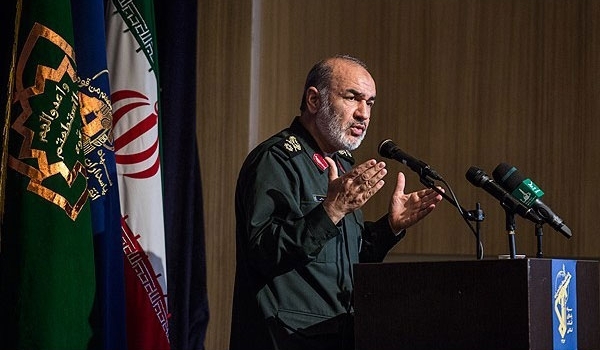IRGC Commander: Iran Possesses Precision-Striking Ballistic Missiles against Mobile Vessels


“(Iran’s) Achievement of the technology to build such missiles is an astonishing phenomenon and we don’t have any information showing that the US or Russia have been able to manufacture ballistic missiles which can target mobile vessels in the sea with a 100% precision,” General Salami said, addressing a forum in Tehran on Tuesday.
He also described the US warships as pieces of “scrap metal”, adding that the American military officials have themselves admitted this fact.
In relevant remarks late last month, General Hossein Salami stressed Iran’s high capability to manufacture different weapons and military equipment, and said the country is able to produce ballistic missiles which can even hit mobile targets.
“On the issue of the production of ballistic missiles against mobile targets, I should say that Iran is among a handful of nations which have access to this know-how,” General Salami told reporters in Tehran.
He also reminded the IRGC’s capabilities in building different drones, electronic warfare systems, ballistic missiles and cyber warfare.
His comments came after Commander of the IRGC Aerospace Force Brigadier General Amir Ali Hajizadeh announced that the country has increased the number of its ballistic missiles, while increasing their precision-striking capability.
“In addition to enhancing the precision-striking power and quality of ballistic missiles, the Iranian authorities and experts have used innovative and shortcut methods to produce inexpensive missiles and today, we are witnessing an increase in production (of ballistic missiles),” General Hajizadeh said in Tehran in December.
Noting that Iran has settled its problems and become self-sufficient in the field of defense and military activities, specially in strategic fields, he said that the country’s experts have been able to boost missiles’ precision-striking power to the utmost.
Also, in August, Iranian Defense Minister Brigadier General Hossein Dehqan underlined that his country sees no limit for the range of the ballistic missiles that it is developing.
“We don’t have any limit for the range of liquid or solid-fueled ballistic missiles,” Dehqan said in a meeting in the Central city of Isfahan.
He underlined the indigenous nature of most Iranian weapons and military equipment, and said, “90 percent of the country’s defense systems have reached an acceptable standard and enjoy competitive quality compared with the weapons of advanced countries; production of the national individual weapons and efforts to improve the quality and precision-striking power of ballistic missiles are among the defense ministry’s achievements in the defense field.”
General Dehqan added that Iranian experts have also taken long strides in building satellites, satellite carriers, missile launchpads and research work in defense areas.
His comments came as the IRGC fired 2 home-made ‘Qadr H’ ballistic missiles from the Eastern Alborz Mountains at a target in Iran’s Southeastern Makran seashore some 1400km away in March 2016.
The missiles were fired on the sidelines of the main stage of the IRGC drills in Central Iran and various parts of the country.
One missile had a message written on it that said in Hebrew: “Israel should be wiped off the Earth”.
Qadr is a 2000km-range, liquid-fuel and ballistic missile which can reach territories as far as Israel.
The missile can carry different types of ‘Blast’ and ‘MRV’ (Multiple Reentry Vehicle) payloads to destroy a range of targets. The new version of Qadr H can be launched from mobile platforms or silos in different positions and can escape missile defense shields due to their radar-evading capability.
A Multiple Reentry Vehicle payload for a ballistic missile deploys multiple warheads in a pattern against a single target. (As opposed to Multiple independently targetable reentry vehicle, which deploys multiple warheads against multiple targets.) The advantage of an MRV over a single warhead is that the damage produced in the center of the pattern is far greater than the damage possible from any single warhead in the MRV cluster, this makes for an efficient area attack weapon. Also, the sheer number of Warheads make interception by Anti-ballistic missiles unlikely.
Improved warhead designs allow smaller warheads for a given yield, while better electronics and guidance systems allowed greater accuracy. As a result MIRV technology has proven more attractive than MRV for advanced nations. Because of the larger amount of nuclear material consumed by MRVs and MIRVs, single warhead missiles are more attractive for nations with less advanced technology. The United States deployed an MRV payload on the Polaris A-3. The Soviet Union deployed MRVs on the SS-9 Mod 4 ICBM.







